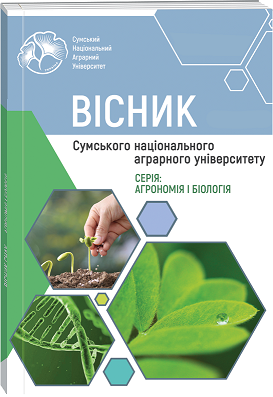INFLUENCE OF PRE-SOWING INOCULATION ON THE PRODUCTIVITY OF DIFFERENT VARIETIES OF WINTER WHEAT
Abstract
The effect of pre-sowing inoculation of Azospirillum sp. and Bacillus sp. 4 and varietal characteristics of winter wheat for the formation of grain productivity of the crop has been studied. The influence of the studied factors on the formation of the crop structure elements has been determined. In particular, it has been found that the 1000 seed weight in the variants averaged from 32.8 to 37.9 g for the Artist variety, and from 40.4 to 43.3 g for the Tobak variety. After pre-sowing inoculation the indicator was in the range of 33.6–35.9 g (Artist variety) and 41.3–42.3 g (Tobak variety). Simultaneous use of Azospirillum sp. and Bacillus sp. 4 for inoculation assisted in the largest increase in the 1000 seed weight: it varied from 37.9 to 43.3 g, depending on.variety. On average, the grain number per ear in control was 24.6–33.6 pieces with a weight of 1.05–1.18 g depending on the variety. Variant with pre-sowing inoculation with Azospirillum sp. + Bacillus sp. 4 led to formation of 37.1–43.3 grains with a seed weight of 1.90–2.09 g. The influence of pre-sowing inoculation on winter wheat yield has been established. The largest increase to control was for the Artist variety 19.4 %, for Tobak variety – 21.0 %. The highest yield of wheat was fixed with the combination of nitrogen-fixing and phosphate-mobilizing bacteria for varieties of Artist and Tobak. It was explained by formation of better ear structure due to favorable root nutrition. Therefore, the effectiveness of pre-sowing inoculation with Azospirillum sp. and Bacillus sp. 4 suspensions in the technology of winter wheat growing has been experimentally proved. For yield increasing the most effective variant was the combined use of bacteria Azospirillum sp. and Bacillus sp. 4. Separately inoculation with each species of microorganism provided an average increase in yield of 5.5 % for the Artist variety and 7.9 % for the Tobak variety. Comparative analysis of yield and its structure of two winter wheat varieties revealed that inoculation with Azospirillum sp. and Bacillus sp. 4 separately and simultaneously, growth in ear parameters of plants and increase of crop yield. Therefore, the use of pre-sowing inoculation of both varieties had a positive effect on yields and indicated the feasibility of this agrotechnological method.
References
2. Dospehov, B. A. (1985). Metodika polevogo opyіta [Field experiment methodology]. Agropromizdat. M. (in Russian).
3. Dubytskyi, O., Kachmar, O., Dubytska, A. & Shcherba, M. (2017). Produktyvnist kolosu ta efektyvnist utvorennia y vidplyvu asymiliativ z lystkiv ozymoi pshenytsi za biolohizovanykh system udobrennia [Ear productivity and efficiency of formation and outflow of assimilates from wheat leaves under biological fertilizer systems]. Visnyk Lvivskoho universytetu. Seriia biolohichna, 76, 215–223 (in Ukrainian).
4. Dumych, V. & Shkoropad, L. (2018). Doslidzhennia efektyvnosti zastosuvannia biopreparativ u tekhnolohiiakh vyroshchuvannia ozymykh zernovykh kultur [Research of efficiency of application of biologicals in technologies of cultivation of grain crops]. Tekhnika i tekhnolohii APK, 2, 19–22 (in Ukrainian).
5. Gallagher, J.N. & Biscoe, P.V. (1978). A physiological analysis of cereal yield. II. Partitioning of dry matter. Agric. Prog., 53, 51–70.
6. Hrabovska, T. O. & Melnyk, H. H. (2017). Vplyv biopreparativ na produktyvnist pshenytsi ozymoi za orhanichnoho vyrobnytstva [Influence of biological products on the productivity of winter wheat in organic production]. Ahrobiolohiia, 1, 81–85 (in Ukrainian).
7. Khalid, M., Zahir, A.Z. & Azhar, W. (1999). Azotobacter and L-tryptophan Application for Improving Wheat Yield. Pakistan Jornal of Biological Scinces, 2 (3), 739–742.
8. Kovalenko, O.A., Kliuchnyk, M.A. & Chebanenko, K.V. (2015). Zastosuvannia biopreparativ dlia obrobky nasinnievoho materialu pshenytsi ozymoi [The use of biological products for the treatment of seeds of winter wheat]. Naukovi pratsi Chornomorskoho derzhavnoho universytetu imeni Petra Mohyly kompleksu «Kyievo-Mohylianska akademiia». Seriia Ekolohiia, 256, 244, 74–77 (in Ukrainian).
9. Kuperman, F.M. (1977). Morfofiziologiya rasteniy [Plant morphology]. Vysshaja shkola, M. (in Russian).
10. Malynovska, I.M., Chernysh, O.O. & Yula, V.M. (2015). Osoblyvosti zastosuvannia kompozytsii mikroorhanizmiv u tekhnolohii vyroshchuvannia pshenytsi yaroi [Features of the application of the composition of microorganisms in the technology of growing spring wheat]. Zbirnyk naukovykh prats NNTs «Instytut zemlerobstva NAAN», 3, 24–31 (in Ukrainian).
11. Metodyka derzhavnoho sortovyprobuvannia silskohospodarskykh kultur [Methods of state varietal testing of crops]. Kyiv, 2001 (in Ukrainian).
12. Mikrobni preparaty v suchasnykh ahrarnykh tekhnolohiiakh [Microbial preparations in modern agricultural technologies] / za red. V.V.Volkohona. Kyiv, 2015 (in Ukrainian).
13. Nasinnia silskohospodarskykh kultur [Seeds of agricultural crops] (2003). Metody vyznachennia yakosti: DSTU 4138-2002. [Chynnyi vid 2004-01-01]. K. : Derzhspozhyvstandart Ukrainy, 173 (in Ukrainian).
14. Shuvar, A.M., Behen, L.L., Dorota, H.M. & Tymkiv, M.Iu. (2020). Zastosuvannia biolohichnykh preparativ v orhanichnii tekhnolohii vyroshchuvannia pshenytsi ozymoi [Application of biological preparations in organic technology of winter wheat cultivation]. Peredhirne ta hirske zemlerobstvo i tvarynnytstvo, 67(I), 143–155 (in Ukrainian). doi: 10.32636/01308521.2020-(67)-1-10
15. Smetanko, O.V. & Buriachkovskyi, V.H. (2009). Efektyvnist biolohichnykh funhitsydiv, stymuliatoriv rostu, mikrodobryv pry zastosuvanni pid ozymu pshenytsiu [The effectiveness of biological fungicides, growth stimulants, microfertilizers in the use of winter wheat]. Visnyk ahrarnoi nauky pivdennoho rehionu, 10, 100–107 (in Ukrainian).
16. Ulukan, H. (2005). Effect of Foliar Fertilizer as Seed Pre-treatment on Yield Components in Common Wheat (Triticum aestivum L.). TARIM BİLİMLERİ DERGİSİ, 11 (4), 368–372.
17. Volkogon, V. V. (1997). Effektivnost bakterizatsii zlakovyih trav azospirillami [Efficiency of bacterization of cereal grasses with azospiriles]. Selskohozyaystvennaya biologiya, 5, 73−77 (in Ukrainian).

 ISSN
ISSN  ISSN
ISSN 



